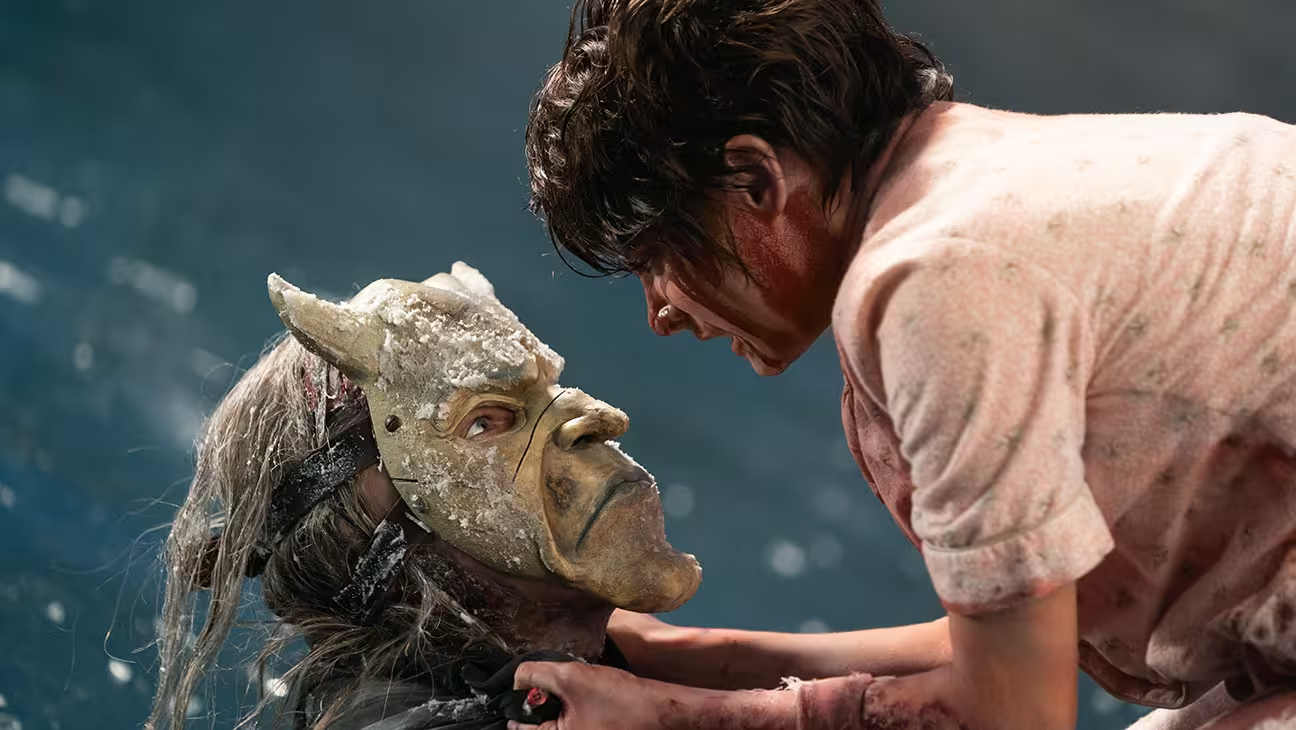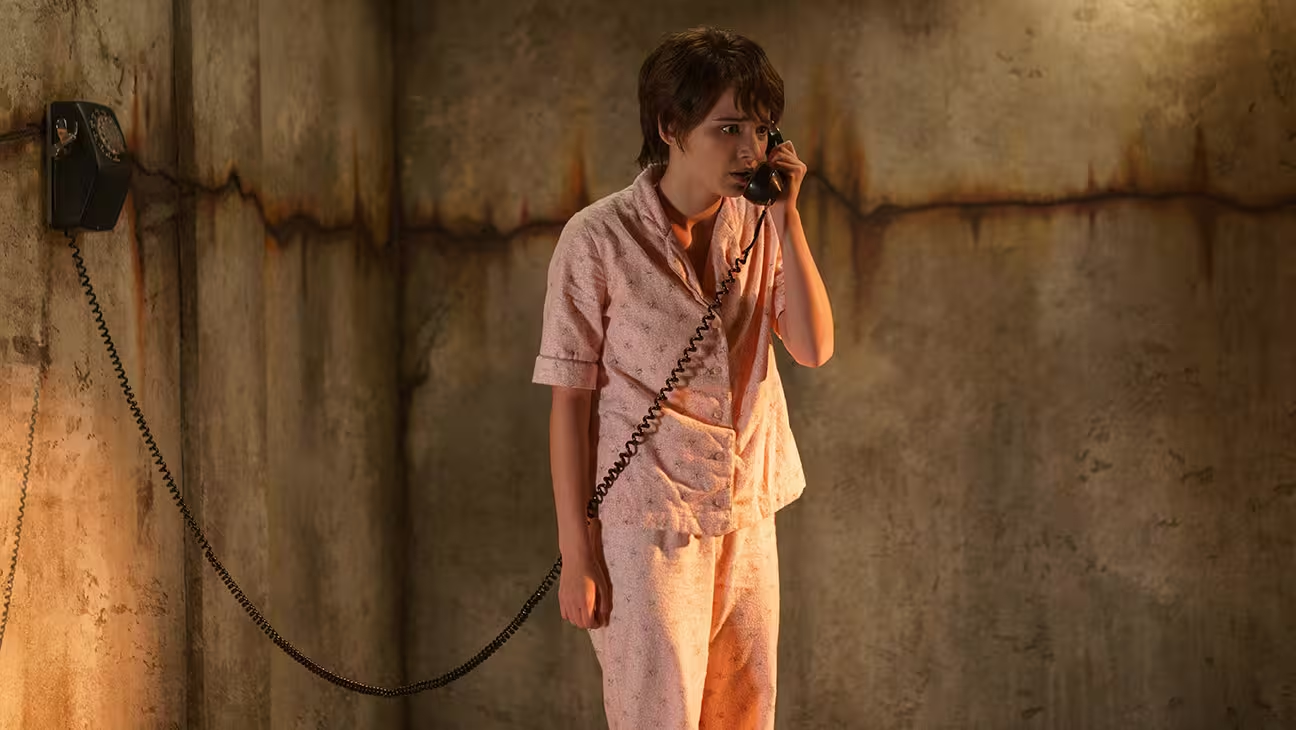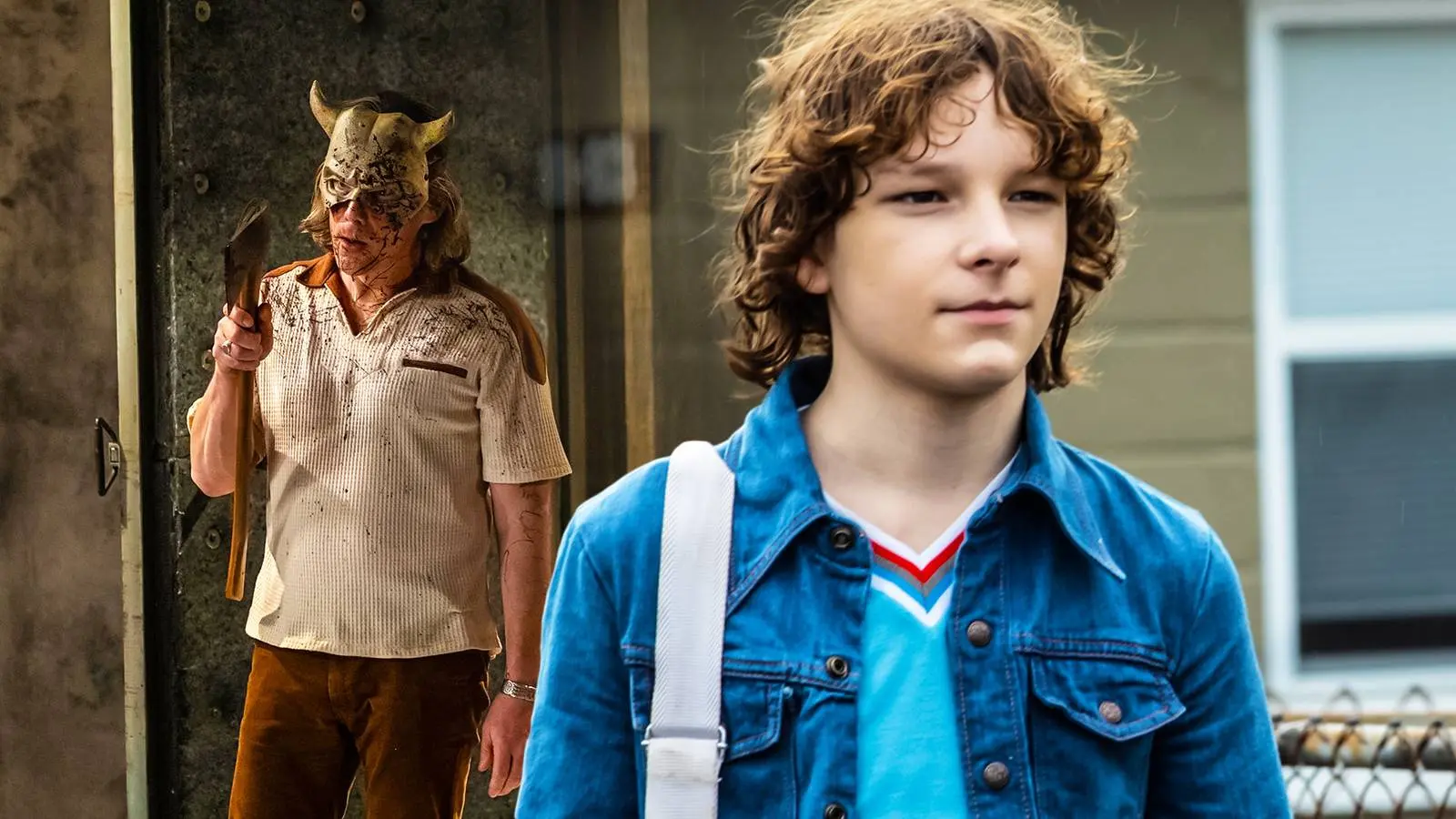12 Minutės
Black Phone 2 scares up a strong opening in a crowded October
Blumhouse and Universal’s Black Phone 2 arrived in theaters as the horror season’s most anticipated sequel and walked away with a solid $26.5 million three-day domestic opening. That haul—powered by an energetic marketing campaign, smart use of premium large format (PLF) screens and an audience that skewed younger and more diverse than the original—positions the film as an early contender for a profitable Halloween tentpole.
The weekend’s story is as much about momentum as raw numbers. After a modest Friday and preview tally, the sequel showed a steadier-than-expected Saturday and finished the frame with a Sunday push that underlined the title’s word-of-mouth strength: overall PostTrak metrics show a 66% definite recommend, a point higher than the first film, and a CinemaScore of B—strong for an R-rated horror release.
How this sequel differs from its predecessor—and why that matters
Scott Derrickson returns to direct, and the creative continuity helps. Where the 2021 Black Phone established the world and emotional core, Black Phone 2 amplifies mood and stakes rather than leaning on flashy gimmicks. That restraint paid off in both critical and audience-facing ways: viewers praised key elements—Ethan Hawke’s continued terrifying presence, Mason Thames’ growth, and a soundtrack moment using Alice in Chains that has become a viral echo across social feeds.

The sequel’s opening is modestly ahead of the first film’s early trajectory when adjusted for box office climate and theatrical capacity, and it stands better against 2025’s crowded horror landscape by delivering a tightly marketed story rather than a spectacle-first approach. This matters because 2025 is shaping up to be a banner year for horror: Comscore reports that domestic horror films have grossed roughly $1.2 billion year-to-date, eclipsing the 2017 figure of $1.16 billion. Blumhouse getting back into the winner’s circle showcases how story-driven horror still connects with audiences when done smartly.
Audience profile: who showed up and why
Demographics tell an interesting tale. Black Phone 2 skewed slightly more male than the original (53% vs. 49%), and the over-25 share remained constant at 53%. But where the sequel really pushed the needle was among Latino and Hispanic audiences: they represented 39% of the crowd, up from 32% for the first film. Native American audiences also reported particularly strong satisfaction and recommendation rates.
Why the jump? Universal’s campaign leaned into targeted multicultural outreach—spots in Liga MX broadcasts, Spanish-language radio, integrations at Premios Juventud and bespoke featurettes with cast members Miguel Mora and Demián Bichir. Mora’s creator screening event, amplified on TikTok, reached 2.5 million viewers in a single recap post. That kind of tailored, culturally savvy outreach matters: when studios bring films to communities in native channels, the payoff is measurable in ticket sales and advocacy.

Marketing that rang true: teasers, texts and TikTok
The Black Phone 2 campaign is a case study in blending old-school TV strategies with modern creator-led activation. Universal spent an estimated $7.2 million in linear TV—which included premium placements during NFL games, college football, MLB and high-profile entertainment shows—yielding 422 million impressions. But the campaign’s edges were digital-first and experiential.
Beginning May 30, press and creators received unsettling text messages from an anonymous Colorado number that teased five atmospheric videos carrying the tagline 'Dead Is Just A Word.' That interactive, slightly creepy touch turned the trailer rollouts into shared moments rather than one-way ads. The second wave of texts on September 4 posed the existential nudge 'What do you think happens when you die?' and premiered the second trailer immediately after. The trailer scoring a spot in YouTube’s first-ever NFL game built a massive streaming reach—trailers for the sequel amassed roughly 336 million views across platforms.
Festival premieres and TikTok activations amplified buzz. The world premiere at Fantastic Fest on September 20 was timed with creators Sam and Colby producing bespoke coverage that reached millions. Late-September TikTok Halloween events—an immersive experience where influencers and cast explored the film’s phone booth and encountered the Grabber—generated custom content that extended reach and encouraged box-office visits.
A savvy partnership with the horror streaming service Shudder (a full takeover across their CTV, desktop and mobile properties from Sept. 19 through Halloween) targeted the core horror audience directly. Add in a Discord mini-game and a custom mod of the online game R.E.P.O., and you have a layered campaign that engaged users across fandom, gaming and social circles.
Exhibitor strategy: PLFs, Dolby and premium grosses
Black Phone 2 benefited from wide distribution—3,411 theaters in the U.S.—and key PLF placements. Close to 1,000 exhibitor PLF screens and 170 AMC Dolby Cinema locations helped the title capture higher per-screen averages in top metros. Shared PLF runs with Tron: Ares accounted for a surprising chunk of earnings; premium auditorium experiences are increasingly important for horror, where atmosphere and sound can transform audience response and justify higher ticket prices.
Top-performing markets included Los Angeles, New York City, Chicago, Dallas and Houston, with the AMC Burbank posting the nation’s highest single-theater gross. Regionally, the movie overperformed on the West Coast, South Central and Midwest—mirroring the demographic spreads the campaign targeted.
Comparisons: Blumhouse vs. the genre and the studio's own past
It’s tempting to compare Black Phone 2 to other recent Blumhouse tentpoles or to bigger studio horror plays like Five Nights at Freddy’s. But the more instructive comparisons are to Blumhouse’s own model and the 2021 original. Blumhouse traditionally trades on lean production budgets, high-concept hooks and strong direct-to-audience marketing. The first Black Phone cost roughly $18 million to make and turned into a $161 million global gross; if the sequel follows a similar profit path with efficient P&A, it should be comfortably profitable.
Contrast that with movies that rely heavily on spectacle or blockbuster-scale budgets—those titles need larger audience turnout and broader demographic spread to break even. Black Phone 2’s approach—returning to atmospheric terror, practical scares and character—feels like a recalibration for Blumhouse in a crowded marketplace.
Cinema historian Marko Jensen, who tracks genre cycles, observes: 'Blumhouse’s strength has always been economical storytelling that leverages cultural word-of-mouth. This sequel proves that when a horror brand respects its audience’s intelligence and leans into atmosphere rather than spectacle, the box office responds.'
Critical and audience reception: what the numbers say
Black Phone 2 is enjoying mostly positive audience response. PostTrak’s 'definite recommend' sits near 66% overall and climbs much higher among younger women and Latino viewers, with single demographics hitting astonishing figures—Latino/Hispanic cinephiles clocked a 75% definite recommend, Native American audiences 78%. Among women under 25, PostTrak reported an 85% positive score with 76% definite recommend; 13–17 year-olds gave it an 88% positive response and an 83% definite recommend. Those are the sorts of numbers that fuel holdovers and multiple-ticket visits during seasonal periods.
Critics’ reviews were more mixed but leaned positive in many outlets, praising Derrickson’s mood and Hawke’s presence while noting the film’s tonal debt to its predecessor. For horror, a strong audience seal is often more predictive than critical acclaim, and Black Phone 2 currently enjoys that advantage.
Where Black Phone 2 sits in 2025’s horror boom
2025 has been a banner year for genre cinema: studios large and small leaned into horror with varying strategies—some went franchise and spectacle, others went niche and auteur-driven. Blumhouse’s win here is partly symbolic: after a year where competitors found success, the company’s return to form suggests that the appetite for theater-based horror remains strong, provided the films are well-targeted and tell a compelling story.
Comscore’s YTD horror total of $1.2 billion is a milestone: the genre isn’t just performing, it’s outpacing previous high-water marks. This fuels a virtuous cycle—studios finance more horror, exhibitor demand for PLF horror increases, and seasonal programming (Halloween Horror Nights, festival genre showcases) drives interest.
Tron: Ares and the mid-run clifftop
Disney’s Tron: Ares, by contrast, illustrates the riskier side of early franchise reboots. After ten days in release, the film sits at roughly $103 million worldwide, a modest return for a franchise relaunch. Domestic fell a steep 67% in its second weekend—larger than the second-weekend drop for a thought-provoking sci-fi like Blade Runner 2049, which declined 53% in its second weekend.
The core issue is twofold: messaging and audience fit. Tron: Ares pitched big-screen spectacle and nostalgia for a legacy IP, but it struggled to maintain momentum beyond initial curiosity. Imax contributed a meaningful chunk ($4.5 million globally, $2.2 million domestic), but the broader decline suggests limited repeat business and patchy word-of-mouth.
Good Fortune: star power isn’t always a crowd-puller
Lionsgate’s Good Fortune, directed by and starring Aziz Ansari with Keanu Reeves and Seth Rogen, opened to a tepid $5.7–6.1 million despite star wattage and a respectable production spend. The film’s B+ CinemaScore and a 59% definite recommend indicate healthy reactions among those who showed up, but turnout fell short of expectations.
Why? The movie plays as a hybrid—an homage to old-school romantic/what-if comedies that also leans into arthouse sensibilities. The marketing measured about 166 million reach across social, but that was 13% below comedy norms. In short: the audience who would see this as a crowd-pleasing event didn’t show up in the numbers the studio hoped for, and coastal, older demos dominated the turnout.
Austerity on the arthouse front: After the Hunt's struggle
Amazon MGM’s After the Hunt expanded into more theaters but struggled to attract large audiences, finishing a second weekend expansion with $1.6 million from 1,238 theaters. The film—featuring big-name actors—hasn't translated prestige or festival interest into mass theatrical attendance. This underlines a continuing industry pattern: auteur-driven films often find larger life on streaming platforms or in awards-season contexts, rather than generating significant theatrical grosses unless they capture a wider cultural conversation.
Faith-based audiences and niche wins
Angel Studios’ Truth & Treason opened with a modest $2.5 million but earned the weekend’s only A CinemaScore thanks to dedicated faith-based audiences. The film’s performance highlights the enduring value of targeted distribution: movies built and marketed for specific communities can perform strongly relative to their scale.
What marketers and studios can learn
Black Phone 2’s success contains several instructive takeaways:
- Targeted multicultural marketing moves the needle. Universal’s decision to actively court Latino and Hispanic audiences—through sports partnerships, radio, talent-led featurettes and creator screenings—produced clear gains in turnout and recommendations.
- Blend mass-reach buys with creator-driven, experiential moments. Heavy linear TV buys during big games secured broad awareness, but the interactive texts, festival activations and TikTok events converted awareness into eagerness.
- PLF and Dolby placements remain crucial for genre films. Horror benefits from immersive audio-visual presentation that encourages higher ticket prices and better per-theater averages.
- Respect the fanbase’s expectations. Black Phone 2 didn’t chase viral gimmicks for their own sake. It built on the original’s mythology and trusted the audience, which fueled repeat intentions.
Box office math and profitability
The original Black Phone was made for roughly $18 million and ultimately grossed $161 million worldwide after ancillary revenue streams. Even with a larger P&A spend for a sequel, a similar multiplier would make the follow-up comfortably profitable. Early returns and strong demographic indicators suggest this sequel could follow a comparable trajectory, particularly if it sustains holds into the Halloween week and benefits from cross-platform merchandising, streaming licensing and label partnerships.
Fan reaction and cultural moments
Online chatter skewed positive. Social listening agencies pointed to people praising sequel logic, Ethan Hawke’s continued menace, and the film’s audio-visual set-pieces. The Alice in Chains needle-drop became a viral talking point—fans said the song’s tone elevated a key sequence and made post-screening discussions buzzworthy. These organic moments—songs, lines, specific scares—are the kinds of micro-cultural currency that drive social sharing and return visits.
What’s next: the calendar and sequel potential
If Black Phone 2 sustains decent holds into the Halloween corridor, Universal and Blumhouse will have breathing room to plan long-term franchise activity. Whether that means additional sequels, spin-offs or a transmedia expansion across streaming and gaming depends on how the film performs in week two and the subsequent four weeks. Marketing teams will watch Latinx and youth metrics closely—if high recommendation numbers there persist, targeted re-ramps and platform placements can amplify final grosses.
Meanwhile, the industry will also keep a close eye on Five Nights at Freddy’s 2 and other fall horror tentpoles to see whether 2025’s genre boom continues to sustain itself.
Behind-the-scenes tidbits
- Scott Derrickson directed both the original and the sequel, maintaining tonal continuity.
- Mason Thames—who first charmed and frightened audiences in the 2021 film—returns with a more mature arc that several critics cited as a highlight.
- Universal integrated Black Phone 2 into Universal Studios’ Halloween Horror Nights with an experiential Terror Tram tie-in that likely drove awareness among theme-park goers.
Final take
Black Phone 2 is a reminder that, in a cinematic ecosystem saturated by spectacle and streaming-first releases, carefully crafted genre cinema still thrives in theaters. Blumhouse’s strategy—lean production, targeted multicultural outreach, strong PLF placements and creator-led hype—brought audiences into seats and gave the studio a timely win.
The film’s success doesn’t erase the larger distribution challenges studios face—some prestige and comedy titles continue to underperform in theatrical windows—but it does offer a playbook: know your audience, meet them where they are, and make the theatrical experience feel like an event worth leaving home for.
Short quoted perspective: 'This sequel proves that horror’s power in theaters comes from atmosphere and audience connection, not just jump scares,' says film critic Ana Kovacs. 'When a studio amplifies community-facing marketing and invests in premium exhibition, the payoff can be both cultural and financial.'
Whether Black Phone 2 sustains momentum through Halloween will determine how far it climbs in the season’s franchise hierarchy. For now, Blumhouse has reclaimed a place at the center of the horror conversation—and that alone is a win in a year when audiences have many reasons to stay home or scroll. Theaters, for the moment, are where the scream is still best heard.
Šaltinis: deadline


Palikite komentarą